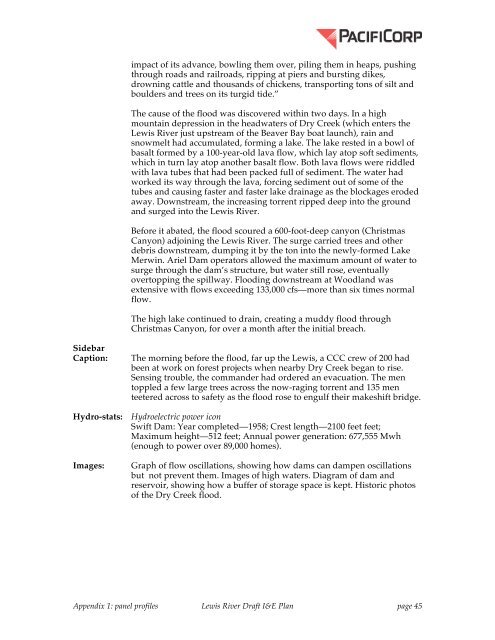The Lewis River Hydroelectric Projects - PacifiCorp
The Lewis River Hydroelectric Projects - PacifiCorp
The Lewis River Hydroelectric Projects - PacifiCorp
Create successful ePaper yourself
Turn your PDF publications into a flip-book with our unique Google optimized e-Paper software.
impact of its advance, bowling them over, piling them in heaps, pushing<br />
through roads and railroads, ripping at piers and bursting dikes,<br />
drowning cattle and thousands of chickens, transporting tons of silt and<br />
boulders and trees on its turgid tide.”<br />
<strong>The</strong> cause of the flood was discovered within two days. In a high<br />
mountain depression in the headwaters of Dry Creek (which enters the<br />
<strong>Lewis</strong> <strong>River</strong> just upstream of the Beaver Bay boat launch), rain and<br />
snowmelt had accumulated, forming a lake. <strong>The</strong> lake rested in a bowl of<br />
basalt formed by a 100-year-old lava flow, which lay atop soft sediments,<br />
which in turn lay atop another basalt flow. Both lava flows were riddled<br />
with lava tubes that had been packed full of sediment. <strong>The</strong> water had<br />
worked its way through the lava, forcing sediment out of some of the<br />
tubes and causing faster and faster lake drainage as the blockages eroded<br />
away. Downstream, the increasing torrent ripped deep into the ground<br />
and surged into the <strong>Lewis</strong> <strong>River</strong>.<br />
Before it abated, the flood scoured a 600-foot-deep canyon (Christmas<br />
Canyon) adjoining the <strong>Lewis</strong> <strong>River</strong>. <strong>The</strong> surge carried trees and other<br />
debris downstream, dumping it by the ton into the newly-formed Lake<br />
Merwin. Ariel Dam operators allowed the maximum amount of water to<br />
surge through the dam’s structure, but water still rose, eventually<br />
overtopping the spillway. Flooding downstream at Woodland was<br />
extensive with flows exceeding 133,000 cfs—more than six times normal<br />
flow.<br />
<strong>The</strong> high lake continued to drain, creating a muddy flood through<br />
Christmas Canyon, for over a month after the initial breach.<br />
Sidebar<br />
Caption:<br />
<strong>The</strong> morning before the flood, far up the <strong>Lewis</strong>, a CCC crew of 200 had<br />
been at work on forest projects when nearby Dry Creek began to rise.<br />
Sensing trouble, the commander had ordered an evacuation. <strong>The</strong> men<br />
toppled a few large trees across the now-raging torrent and 135 men<br />
teetered across to safety as the flood rose to engulf their makeshift bridge.<br />
Hydro-stats: <strong>Hydroelectric</strong> power icon<br />
Swift Dam: Year completed—1958; Crest length—2100 feet feet;<br />
Maximum height—512 feet; Annual power generation: 677,555 Mwh<br />
(enough to power over 89,000 homes).<br />
Images:<br />
Graph of flow oscillations, showing how dams can dampen oscillations<br />
but not prevent them. Images of high waters. Diagram of dam and<br />
reservoir, showing how a buffer of storage space is kept. Historic photos<br />
of the Dry Creek flood.<br />
Appendix 1: panel profiles <strong>Lewis</strong> <strong>River</strong> Draft I&E Plan page 45
















